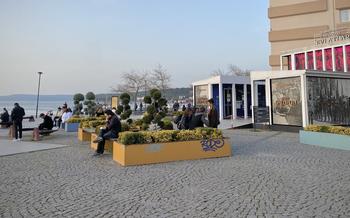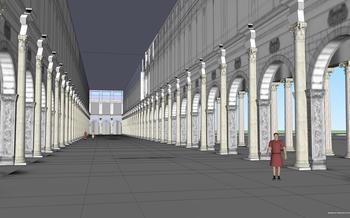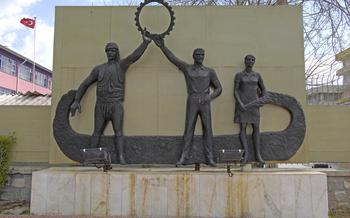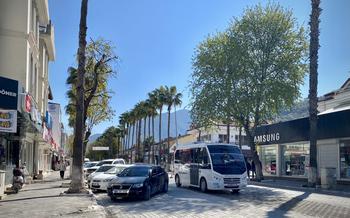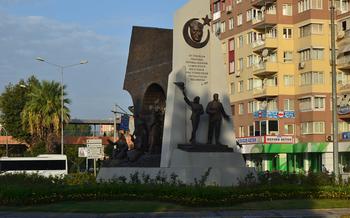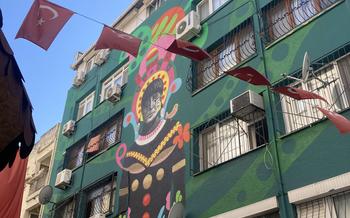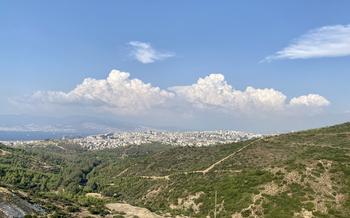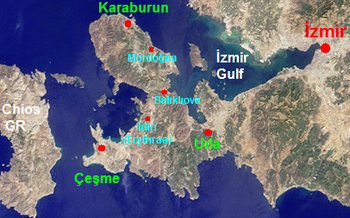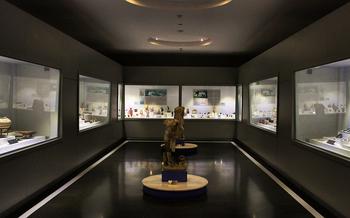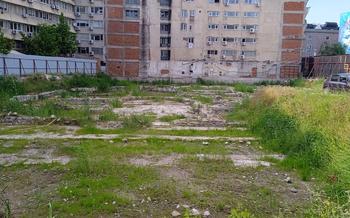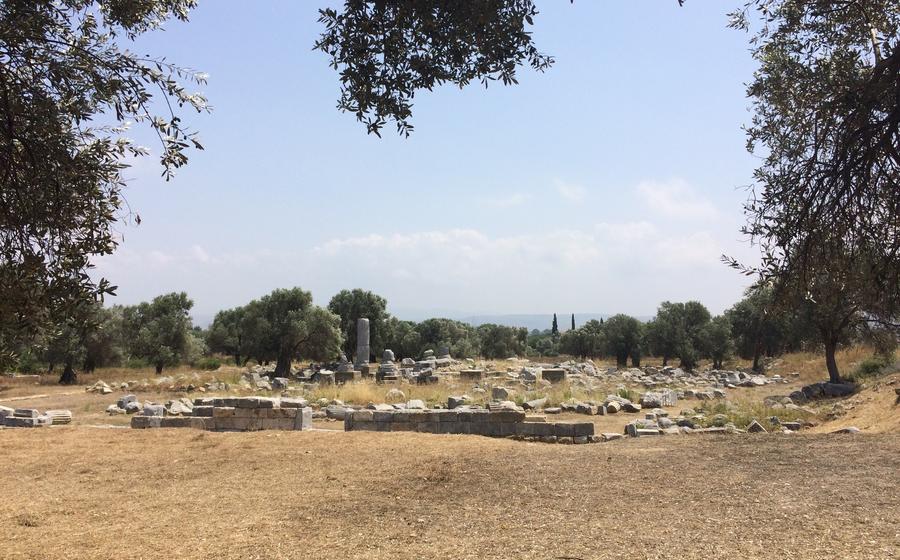
Teos Ancient City
- Historical Background
- Geographical Location
- Archaeological Excavations
- City Walls and Gates
- Agora and Public Buildings
- Theater and Odeon
- Necropolis
- Aqueduct and Water System
- Harbor and Trade
- Pottery and Craftsmanship
- Coinage and Currency
- Hellenistic and Roman Periods
- Byzantine and Ottoman Periods
- Insider Tip:
Historical Background
Teos, an ancient Ionian city founded around the 11th century BC, holds a significant place in the history of the region. Its strategic location on the Aegean coast and its fertile lands attracted early settlers who established a prosperous community. Over time, Teos became a renowned center of culture, art, and philosophy, contributing to the intellectual and artistic legacy of ancient Greece. The city's inhabitants, known as Teans, played an active role in maritime trade and established strong relations with other Greek city-states. Teos was also home to a flourishing religious tradition, with temples and sanctuaries dedicated to various deities, reflecting the deep spiritual beliefs of its people. Legends and myths associated with the city, such as the tale of the seeress Bianor and the founding of Teos by the hero Athamas, add an air of mystery and fascination to its rich history.
Geographical Location
Teos, an ancient Ionian city, enjoyed a strategic location on the Aegean coast of Turkey, in the modern-day province of İzmir. Situated on a small peninsula, Teos overlooked the picturesque Teos Bay and was surrounded by verdant mountains. The city's strategic position allowed for easy access to the sea, facilitating trade and maritime activities. Its proximity to other prominent ancient cities, such as Ephesus, Miletus, and Priene, further contributed to its significance as a regional center.
Reaching Teos from İzmir is a breeze, with various transportation options available. Visitors can take a scenic bus ride or drive along the winding roads that offer breathtaking views of the countryside. The city's proximity to İzmir Adnan Menderes Airport (ADB) makes it easily accessible for international travelers.
The best time to visit Teos is during the shoulder seasons (spring and autumn), when the weather is pleasant and the crowds are smaller. Summer months can be hot and crowded, while winter can bring unpredictable weather conditions. However, each season offers its unique charm, with spring showcasing wildflowers in bloom and autumn displaying vibrant foliage.
Archaeological Excavations
The ancient city of Teos has been the subject of extensive archaeological excavations since the late 19th century. These excavations have uncovered a wealth of information about the city's history, culture, and architecture. Some of the most significant discoveries include the city walls, the agora, the theater, and the necropolis.
The excavations at Teos have also shed light on the city's role as a center of culture and art. Numerous sculptures, inscriptions, and other artifacts have been found, providing valuable insights into the artistic and intellectual life of the ancient Teans.
Despite the progress made in excavating Teos, much of the city remains buried beneath the soil. Ongoing excavations and research continue to uncover new information about this fascinating ancient city.
One of the most challenging aspects of excavating Teos is the fact that the site is located in a modern agricultural area. This means that archaeologists must work carefully to avoid damaging the crops and the surrounding environment.
Another challenge is the fact that Teos was built on a hilltop, which makes it difficult to access some of the ruins. However, these challenges have not deterred archaeologists from their work, and they continue to make important discoveries that help us to better understand the ancient world.
City Walls and Gates
The city walls of Teos, constructed in the 4th century BC, served as a formidable defense against potential threats. Built with large polygonal blocks, the walls featured a thickness of up to 3 meters and reached a height of 8 meters. Strategically placed towers and bastions further reinforced the walls, providing archers and defenders with elevated vantage points.
Teos had several gates that provided access to the city. The main gate, known as the West Gate, was particularly impressive, adorned with intricate carvings and inscriptions. The East Gate, facing the sea, allowed for easy access to the harbor and facilitated trade and maritime activities. Smaller postern gates, located at various points along the walls, served as secondary entrances and exits for residents and soldiers.
The city walls and gates played a crucial role in protecting Teos from potential invaders, whether by land or sea. Their strategic design and construction ensured that the city remained secure and well-defended throughout its history.
Agora and Public Buildings
The agora, or central public space, of Teos was a bustling hub of activity, serving as a marketplace, a gathering place for citizens, and a stage for political and social events. The agora was a large, open area surrounded by colonnades and lined with public buildings, each serving a specific function.
The bouleuterion, or council chamber, was where the city council met to discuss and decide on important matters. The prytaneion, or town hall, housed the city's administrative offices and served as a place for officials to conduct business. Temples dedicated to various deities were also located within or near the agora, reflecting the religious nature of public life in ancient Teos.
Significant architectural features and artifacts found in these buildings include inscriptions commemorating civic achievements, statues of prominent citizens, and altars used for religious ceremonies. The agora and its surrounding structures played a vital role in the political, social, and economic life of Teos, facilitating trade, governance, and the exchange of ideas among its citizens.
Theater and Odeon
The theater and odeon in Teos were magnificent venues for cultural and artistic performances. Constructed in the 4th century BC, the theater had a seating capacity of over 3,000 spectators. Its well-preserved stone seats are arranged in a semicircle, offering a commanding view of the stage. The theater hosted a variety of performances, including plays, concerts, and political assemblies. The acoustics are remarkable, ensuring that even those in the back rows could hear the actors clearly.
Adjacent to the theater is the smaller odeon, built in the 2nd century AD. It has a more intimate setting, with a capacity of around 1,000 people. The odeon was primarily used for musical performances and recitals. Both venues were adorned with intricate carvings and sculptures, showcasing the artistic prowess of the ancient Teans. Attending a performance in these theaters would have been a captivating experience, immersing the audience in the vibrant cultural scene of ancient Teos.
Necropolis
The necropolis of Teos, located to the east of the ancient city, offers a glimpse into the burial practices and beliefs of the ancient Teans. The necropolis consists of various types of tombs, including rock-cut tombs, chamber tombs, and tumuli, each with unique architectural features.
The rock-cut tombs, carved into the soft rock formations, are often simple in design with a single chamber. Chamber tombs, on the other hand, are more elaborate, featuring multiple chambers and niches for burials. Tumuli, or burial mounds, are circular or oval in shape and contain one or more burial chambers beneath a mound of earth and stones.
Within the tombs, archaeologists have discovered a wealth of funerary objects, including pottery vessels, jewelry, coins, and personal belongings. These objects provide insights into the wealth and status of the deceased, as well as their beliefs about the afterlife.
The necropolis also reveals the social hierarchy of Teos, with larger and more elaborate tombs belonging to prominent citizens and wealthy families. Some tombs feature inscriptions or reliefs depicting the deceased and their accomplishments, offering glimpses into their lives and legacies.
Exploring the necropolis of Teos provides a poignant reminder of the lives and deaths of the ancient Teans, shedding light on their customs, beliefs, and social structures.
Aqueduct and Water System
Teos, like many ancient cities, relied on a sophisticated water management system to meet the daily needs of its inhabitants. A remarkable feat of engineering, the Teos aqueduct transported water from a distant source to the city, ensuring a steady supply for drinking, sanitation, and irrigation.
Constructed with meticulous precision, the aqueduct consisted of a series of underground channels and above-ground pipelines that spanned several kilometers. The water source, often a natural spring or river located in the nearby mountains, was carefully selected for its purity and abundance. From there, the water was directed into a network of terracotta pipes, expertly crafted to withstand pressure and prevent leakage.
The aqueduct's route was meticulously planned to follow the natural contours of the land, ensuring a gentle gradient that allowed water to flow smoothly without losing pressure. Along its course, the aqueduct passed through tunnels carved through hills and crossed valleys on sturdy stone bridges, showcasing the ingenuity and determination of the ancient Teans.
At strategic points, the aqueduct featured reservoirs and settling tanks, where sediment and impurities could settle out, ensuring that the water reaching the city was clean and safe for consumption. These reservoirs also served as distribution points, where water was diverted to various parts of the city through a network of smaller pipes.
The construction and maintenance of the aqueduct required considerable resources and expertise. Teams of skilled laborers worked tirelessly to build and repair the system, ensuring a continuous supply of water for the city's growing population. The aqueduct not only provided essential sustenance but also contributed to the overall health and prosperity of Teos, allowing its inhabitants to thrive and flourish.
Harbor and Trade
Teos' strategic location on the Aegean coast made it a natural hub for maritime trade and commerce. The city's harbor, protected by natural features such as a sheltered bay and breakwaters, provided safe anchorage for ships from across the Mediterranean. This strategic position allowed Teos to flourish as a trading center, connecting it with other Greek city-states, as well as with the broader Mediterranean world.
Tean merchants engaged in a lively trade in various goods, including agricultural products, textiles, pottery, and metalwork. The city was particularly renowned for its high-quality ceramics and terracotta figurines, which were exported to distant markets. In return, Teos imported goods such as wine, olive oil, and luxury items from other regions.
The harbor also played a crucial role in the city's fishing industry. Tean fishermen ventured out into the Aegean Sea, bringing back a rich catch of fish and other marine resources that contributed to the city's food supply and economy.
The bustling harbor and thriving trade brought wealth and prosperity to Teos. The city's merchants and traders formed a powerful and influential class, playing a significant role in the city's political and economic affairs. Teos' harbor remains a testament to the city's maritime prowess and its pivotal role in ancient Mediterranean trade networks.
Pottery and Craftsmanship
Teos was renowned for its thriving pottery industry, which produced distinctive ceramics and terracotta figurines that were highly prized throughout the ancient world. The city's potters were skilled artisans who employed various techniques and materials to create a unique artistic style. They utilized local clay, which was known for its exceptional quality and plasticity, allowing them to mold intricate forms and achieve a vibrant red color after firing.
Tean potters produced a wide range of pottery, including utilitarian vessels for everyday use, such as amphorae, jugs, and bowls, as well as decorative items like figurines and statuettes. Their pottery was often adorned with intricate patterns and motifs, featuring mythological scenes, floral designs, and depictions of animals. The potters demonstrated a mastery of both wheel-thrown and hand-built techniques, creating both delicate and robust pieces.
Several pottery workshops and kilns have been discovered at the site of Teos, providing valuable insights into the production process. These workshops were typically located near the city's harbor, allowing for easy access to raw materials and transportation of finished goods. The kilns, often constructed with multiple chambers, enabled potters to fire their ceramics at high temperatures, achieving a durable and aesthetically pleasing finish.
The pottery industry played a significant role in the economy and cultural identity of Teos. The city's potters supplied both local and international markets with their high-quality ceramics, contributing to Teos's prosperity and reputation as a center of craftsmanship. The distinctive style and quality of Tean pottery continue to be admired and studied by archaeologists and art historians, serving as a testament to the skill and creativity of the ancient Tean artisans.
Coinage and Currency
Teos, like many other ancient Greek city-states, issued its own coinage. The Tean coins were minted in silver and bronze and featured a variety of designs and symbols. The most common motif on Tean coins was the head of Dionysus, the god of wine and revelry, who was widely worshipped in the city. Other deities depicted on Tean coins included Apollo, Athena, and Hermes. The coins also featured symbols associated with Teos, such as the bunch of grapes, the thyrsus (a staff with a pine cone tip), and the owl.
The coinage of Teos provides valuable insights into the city's economy and trade. The fact that Teos minted its own coins suggests that it had a developed monetary system and engaged in extensive trade with other Greek cities. The iconography on the coins also sheds light on the religious beliefs and cultural identity of the Teans.
Several hoards of Tean coins have been discovered by archaeologists, providing further evidence of the city's economic importance. One of the most significant hoards was found in 1932 near the ancient city of Ephesus. The hoard contained over 1,000 Tean coins, dating from the 5th to the 3rd century BC. The coins were in excellent condition, suggesting that they had been buried for safekeeping during a time of crisis.
The coinage of Teos is a valuable source of information about the city's history, economy, and culture. The coins provide a tangible link to the past and offer a glimpse into the daily lives of the ancient Teans.
Hellenistic and Roman Periods
During the Hellenistic period, Teos came under the influence of the powerful Hellenistic kingdoms, such as the Seleucids and the Ptolemies. The city adopted many aspects of Hellenistic culture, including its art, architecture, and philosophy. This influence is evident in the construction of new buildings, such as the gymnasium and the theater, which were built in the Hellenistic style.
In the 1st century BC, Teos was incorporated into the Roman Empire. Under Roman rule, the city continued to prosper and expand. The Romans built new roads and aqueducts, and they also introduced new forms of government and administration. Teos became a prominent center of trade and commerce, and it was granted the status of a free city by the Roman emperor Augustus.
Byzantine and Ottoman Periods
During the Byzantine period, Teos experienced a gradual decline due to a combination of factors, including natural disasters, invasions, and shifting trade routes. The city's strategic importance waned as the Byzantine Empire focused on other regions. As a result, Teos's population dwindled, and its once-thriving economy faltered. Eventually, the city was abandoned, and its ruins lay forgotten for centuries.
In the Ottoman period, the region where Teos once stood came under Ottoman rule. However, the Ottomans showed little interest in the ancient city, and it remained largely neglected. Over time, the ruins of Teos were gradually covered by vegetation and soil, further obscuring their existence. Today, only a fraction of the ancient city has been excavated and restored, offering a glimpse into Teos's rich past.
Insider Tip:
To truly immerse yourself in the history and significance of Teos, consider booking a tour with a knowledgeable local guide. These guides often have a wealth of information and can provide insights that you might miss on your own. If you prefer a more independent experience, visit Teos during the off-season (October to April) to avoid the crowds and enjoy a more peaceful exploration. During this time, you'll have the opportunity to soak in the atmosphere and contemplate the grandeur of this ancient city without the hustle and bustle of other tourists.
Keep an eye out for special events or festivals that may be held in Teos or nearby areas. These events often showcase the rich cultural heritage of the region and provide a unique opportunity to experience the vibrant spirit of modern-day Turkey.
For photography enthusiasts, Teos offers a treasure trove of stunning vistas and picturesque ruins. Be sure to bring your camera and capture the golden hues of the ancient stones against the backdrop of the azure sky and sparkling sea. The play of light and shadow on the ruins, especially during sunrise and sunset, creates a magical ambiance that is sure to captivate your senses.
